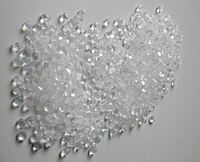
Effect of the Cr2O3 and TiO2 as nucleating agents in SiO2-Al2O3-CaO-MgO glass-ceramic system
Sign Up to like & getrecommendations! Published in 2017 at "Metals and Materials International"
DOI: 10.1007/s12540-017-6714-9
Abstract: The nucleation agent is one of the most important factors in glass-ceramics as it can control either the crystallization temperature or the activation energy. In this study, we investigated the effect of two common nucleation… read more here.
Keywords: cr2o3; effect; nucleation; sio2 al2o3 ... See more keywords

Effect of crystallization temperature on glass-ceramics derived from tailings waste
Sign Up to like & getrecommendations! Published in 2020 at "Journal of Alloys and Compounds"
DOI: 10.1016/j.jallcom.2020.155503
Abstract: Abstract Sintered glass-ceramics containing CaO–Al2O3–SiO2 were successfully fabricated by application of sinter-crystallization process, with tungsten tailings waste (TTW) as main raw materials. Crystallization kinetics analysis showed that surface crystallization dominated the overall crystallization process and… read more here.
Keywords: crystallization temperature; tailings waste; glass ceramics; crystallization ... See more keywords

Enhanced ferroelectric properties of P(VDF-TrFE) thin film on single-layer graphene simply adjusted by crystallization condition
Sign Up to like & getrecommendations! Published in 2021 at "Materials Today Energy"
DOI: 10.1016/j.mtener.2021.100678
Abstract: Abstract Ferroelectric polymer/graphene hybrid systems have received considerable attentions due to their promising utilizations in flexible electronics. The crystallization of ferroelectric polymers such as poly(vinylidene fluoride-trifluoroethylene) P(VDF-TrFE) can obviously affect the electronic properties of the… read more here.
Keywords: vdf trfe; crystallization temperature; graphene; temperature ... See more keywords

Influence of isothermal crystallization temperature on the temperature rising elution fractionation for a poly(1-butene-co-ethylene) resin
Sign Up to like & getrecommendations! Published in 2021 at "Polymer"
DOI: 10.1016/j.polymer.2021.123584
Abstract: Abstract Temperature Rising Elution Fractionation (TREF) is effective for separating polyolefin resins according to crystallizability. A relatively low isothermal crystallization temperature is necessary to fractionate poly(1-butene) (PB-1) resin because of its slow crystallization kinetics. This… read more here.
Keywords: ethylene; crystallization temperature; poly butene; temperature ... See more keywords

Crystallization Temperature, Vapor Pressure, Density, Viscosity, and Specific Heat Capacity of the LiNO3/[BMIM]Cl/H2O Ternary System
Sign Up to like & getrecommendations! Published in 2017 at "Journal of Chemical & Engineering Data"
DOI: 10.1021/acs.jced.7b00059
Abstract: The crystallization temperature, vapor pressure, density, viscosity, and specific heat capacity for the ternary system of LiNO3/[BMIM]Cl/H2O with a mass ratio (LiNO3:[BMIM]Cl) of 2:1 were measured. The crystallization temperature was measured from w = 0.65… read more here.
Keywords: bmim h2o; vapor pressure; h2o; lino3 bmim ... See more keywords

Determination of the Crystallization Temperature of Mullite by Luminescence Spectra of Europium and Chromium Ions
Sign Up to like & getrecommendations! Published in 2019 at "Physics of the Solid State"
DOI: 10.1134/s1063783419120163
Abstract: The luminescence spectra of Cr3+ and Eu3+ ions embedded in mullite ceramic samples are studied. The samples were annealed at temperatures from 600 to 1200°C. From the temperature of 800°C, the spectra demonstrated the presence… read more here.
Keywords: luminescence spectra; determination crystallization; luminescence; temperature mullite ... See more keywords

Mechanism of Nano-Structuring Manipulation of the Crystallization Temperature of Superlattice-like [Ge8Sb92/Ge]3 Phase-Change Films
Sign Up to like & getrecommendations! Published in 2020 at "Nanomaterials"
DOI: 10.3390/nano11010020
Abstract: Superlattice-like (SLL) phase-change film is considered to be a promising phase-change material because it provides more controllabilities for the optimization of multiple performances of phase-change films. However, the mechanism by which SLL structure affects the… read more here.
Keywords: change films; change; crystallization temperature; phase change ... See more keywords